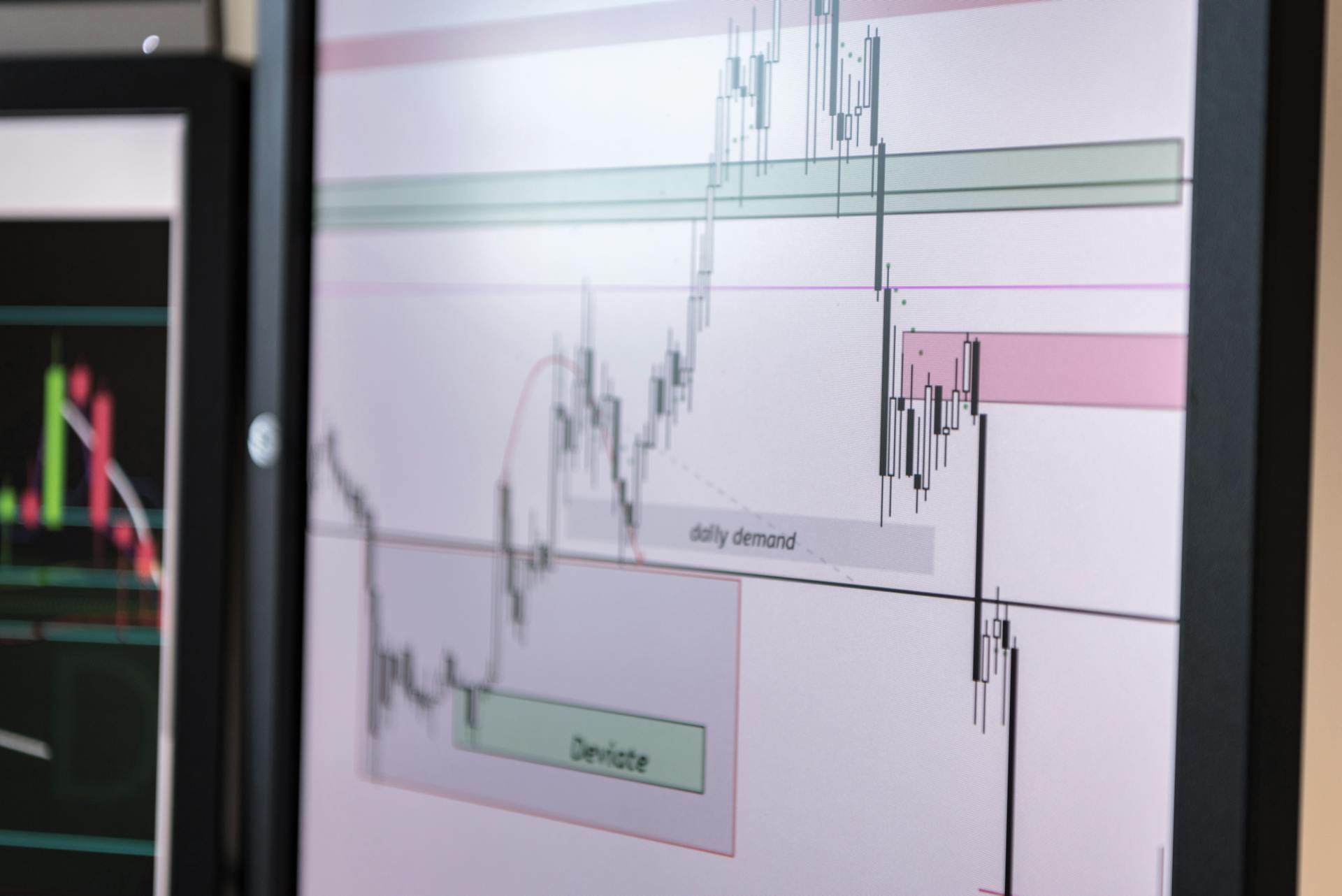
In the US economy, a normal yield curve is typically observed, where longer-term bonds have higher yields than shorter-term bonds. This is because investors demand higher returns for taking on more risk by lending for longer periods.
The normal yield curve is a reflection of the US economy's strong growth prospects and low inflation. For example, in 2019, the 10-year Treasury bond yield averaged around 2.1%, while the 2-year Treasury bond yield averaged around 1.9%.
A normal yield curve is a sign of a healthy economy, where investors are willing to lend for longer periods at higher yields. In contrast, an inverted yield curve is a warning sign of potential economic downturn.
In an inverted yield curve, shorter-term bonds have higher yields than longer-term bonds, which is a rare occurrence in the US economy.
A different take: United States Treasury Security
Key Concepts and Takeaways
A normal yield curve slopes upward, displaying yields that run from low to high as maturities increase.
An inverted yield curve is unusual and forms when short-term debt instruments have higher yields than long-term instruments of the same credit risk profile.
The yield curve graphically represents yields on similar debt securities across a variety of maturities.
A yield curve inverts when long-term interest rates drop below short-term rates, indicating that investors are moving money away from short-term bonds and into long-term ones.
Market participants and economists use a variety of yield spreads as a proxy for the yield curve.
Here are some key characteristics of yield curves:
- Normal yield curve: upward sloping, with yields increasing as maturities increase.
- Inverted yield curve: downward sloping, with short-term yields higher than long-term yields.
- Yield curve inversion: long-term interest rates drop below short-term rates.
- Yield spreads: used as a proxy for the yield curve, with no general agreement on which spread is the most reliable recession indicator.
An inverted Treasury yield curve has proven in the past to be one of the most reliable leading indicators of a recession.
Historical and Economic Context
A normal yield curve is the most common and generally reflects a stable and expanding economy. It's characterized by lower yields for shorter-term maturities and progressively higher yields for longer-term maturities.
A normal yield curve can provide clues about the current and expected pace of economic activity. For example, a comparatively steeper normal yield curve can reflect accelerating rates of economic growth.
The shape of the yield curve has historically been a reliable indicator of economic trends. Inverted yield curves, on the other hand, have historically exhibited a strong correlation with economic recession.
Additional reading: Overbites Normal
Historical Examples
The 10-year to two-year Treasury spread has been a generally reliable recession indicator since providing a false positive in the mid-1960s.
In 1998, the 10-year/two-year spread briefly inverted after the Russian debt default, and the Federal Reserve's quick interest rate cuts helped avert a U.S. recession.
The spread inverted for much of 2006, and long-term Treasury bonds went on to outperform stocks during 2007, the year the Great Recession began in December.
The 10-year/two-year spread briefly went negative on Aug. 28, 2019, and the U.S. economy suffered a two-month recession in February and March of 2020 amid the COVID-19 pandemic.
An inverted yield curve has often preceded recessions in recent decades, but it does not cause them; instead, bond prices reflect investors' expectations that longer-term yields will decline, as typically happens in a recession.
A fresh viewpoint: Us Treasury Inflation Protected Securities Tips
U.S. Treasury Shape and Economic Expectations
The shape of the U.S. Treasury yield curve can reveal valuable insights about economic expectations.
A normal yield curve, characterized by lower yields for shorter-term maturities and progressively higher yields for longer-term maturities, is the most common and generally reflects a stable and expanding economy.
This type of curve often indicates a stable economy, but the relative steepness can provide clues about the current and expected pace of economic activity.
A steeper normal yield curve can reflect accelerating rates of economic growth, while a less steep one can indicate a slowing pace of economic expansion.
A flat yield curve, marked by similar yields across both short-term and long-term maturities, often reflects uncertain or deteriorating economic conditions.
This type of curve can indicate concerns of further economic weakness and is often a sign of economic uncertainty.
An inverted yield curve, where short-term yields are higher than longer-term yields, is rare and generally reflects periods of significant economic slowdown and possibly recession.
Historically, inverted yield curves have exhibited a strong correlation with economic recession, serving as a warning sign for investors and policymakers.
You might like: What Is Economic Growth
Expert Insights and Analysis
Normal vs inverted yield curve is a topic that has sparked intense debate among economists and investors.
The inverted yield curve is a sign of economic recession, as seen in the 2007-2009 financial crisis.
In a normal yield curve, short-term interest rates are lower than long-term interest rates, which is a sign of economic growth.
This is because investors are willing to lend money for longer periods of time, expecting higher returns in the future.
However, in an inverted yield curve, short-term interest rates are higher than long-term interest rates, which is a sign of economic uncertainty.
This can be a warning sign for investors, indicating that a recession may be on the horizon.
For your interest: How Many Days Has the Yield Curve Been Inverted
Indicative Spreads
Experts have different opinions on which spread to focus on when gauging recession risk. Federal Reserve Chair Jerome Powell prefers to look at the difference between the current three-month Treasury bill rate and the market pricing of derivatives predicting the same rate 18 months later.
The spread between the yields on the 10-year and two-year U.S. Treasury bonds is a popular choice among investors, who use it as a yield curve proxy and a relatively reliable leading indicator of a recession. Some Federal Reserve officials argue that focusing on shorter-term maturities is more informative about the likelihood of a recession.
The 10-year to 2-year spread is often used by investors to gauge recession risk. This spread has been studied extensively in academic research.
Paul Krugman
Paul Krugman, a renowned economist, has a clear stance on the inverted yield curve, attributing it to investor expectations. He believes that the long-term rate is a prediction of future short-term rates, and if investors expect the economy to contract, the yield curve will be negatively sloped.
Krugman's framework suggests that investors' expectations drive the historical pattern of the yield curve. He notes that if investors expect the economy to expand, the Fed will raise rates, making the yield curve positively sloped.
You might like: Interest Rates and Bond Valuation
However, there are problems with Krugman's approach. The first issue is that if investors already know a recession is coming, why would an inverted yield curve spook them? This raises questions about the validity of using the inverted yield curve as a recession predictor.
According to Krugman, the yield curve inverts because investors expect a weak economy, which will force the Fed into repeated rate cuts. But, as we'll see, the data doesn't entirely support this explanation.
An Austrian Explanation
In Austria, the concept of work-life balance is deeply ingrained in the culture.
The country's strong emphasis on leisure time is reflected in its generous annual leave policy, which allows employees to take up to 60 days off per year.
Austrians prioritize time off to recharge and pursue hobbies, often returning to work refreshed and productive.
The country's unique approach to work-life balance has been shown to improve employee well-being and job satisfaction.
As a result, Austria consistently ranks high in the OECD's Better Life Index, which measures well-being across various dimensions.
Intriguing read: Venezuela Currency over Time
Investor Guidance and Education
As an investor, it's essential to understand the implications of an inverted yield curve. Historically, protracted inversions of the yield curve have preceded recessions in the U.S.
This is because an inverted yield curve reflects investors' expectations for a decline in longer-term interest rates as a result of a deteriorating economic performance. This can be a sign of trouble ahead.
If you're considering investing in a market with an inverted yield curve, be aware that it may be a signal of an impending recession. An inverted yield curve is not a guarantee of a recession, but it's a warning sign that you should take seriously.
It's crucial to diversify your portfolio and be prepared for a potential downturn.
Current Market and Economic Situation
The current market and economic situation is a bit of a mixed bag. The yield curve has been inverted for 476 consecutive days, which is the longest stretch in data going back to 1962. This has left many market participants on edge, as inverted yield curves have historically been a reliable predictor of recession.
The current inversion is also the deepest in over 40 years, adding to concerns about the economy's prospects. The Federal Reserve Bank of New York's recession probability model is highly elevated at 61.47%, which suggests that many experts believe a recession is likely.
Despite these concerns, the US economy has remained remarkably resilient in 2023, with strong consumer spending and a robust labor market supporting growth. However, the yield curve inversion has not yet returned to a normal, upward-sloping curve.
The question on everyone's mind is whether the economy will continue to defy the yield curve's warning signs or if a recession is indeed looming.
You might enjoy: Look at the below Yield Curve Inversion Chart
Frequently Asked Questions
Is an inverted yield curve good or bad?
An inverted yield curve is generally considered a bad sign for the economy, indicating potential economic downturn. It suggests investors are preparing for a recession by holding onto short-term cash reserves.
What is an inverted yield curve usually a good indicator of?
An inverted yield curve is usually a good indicator of an impending economic recession. This warning sign has historically preceded economic downturns, making it a key indicator for investors and economists to watch.
Sources
- https://www.investopedia.com/terms/i/invertedyieldcurve.asp
- https://www.schwab.com/learn/story/understanding-yield-curve
- https://mises.org/understanding-money-mechanics/inverted-yield-curve-and-recession
- https://russellinvestments.com/us/blog/inverted-yield-curve
- https://newyorkclass.org/shape-u-s-treasury-yield-curve/
Featured Images: pexels.com


